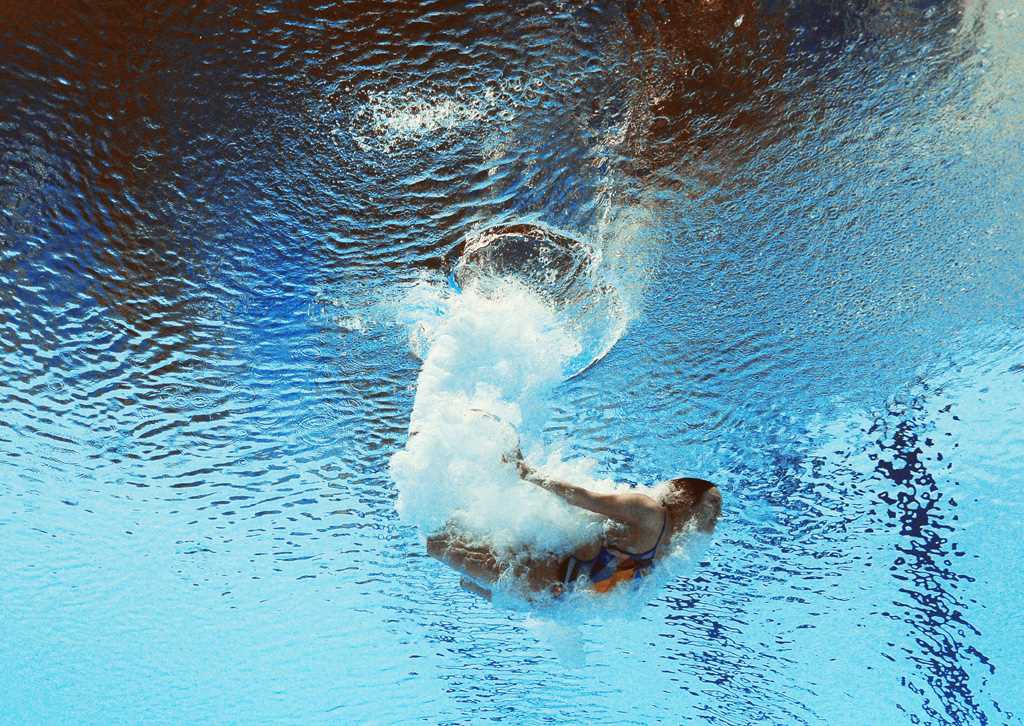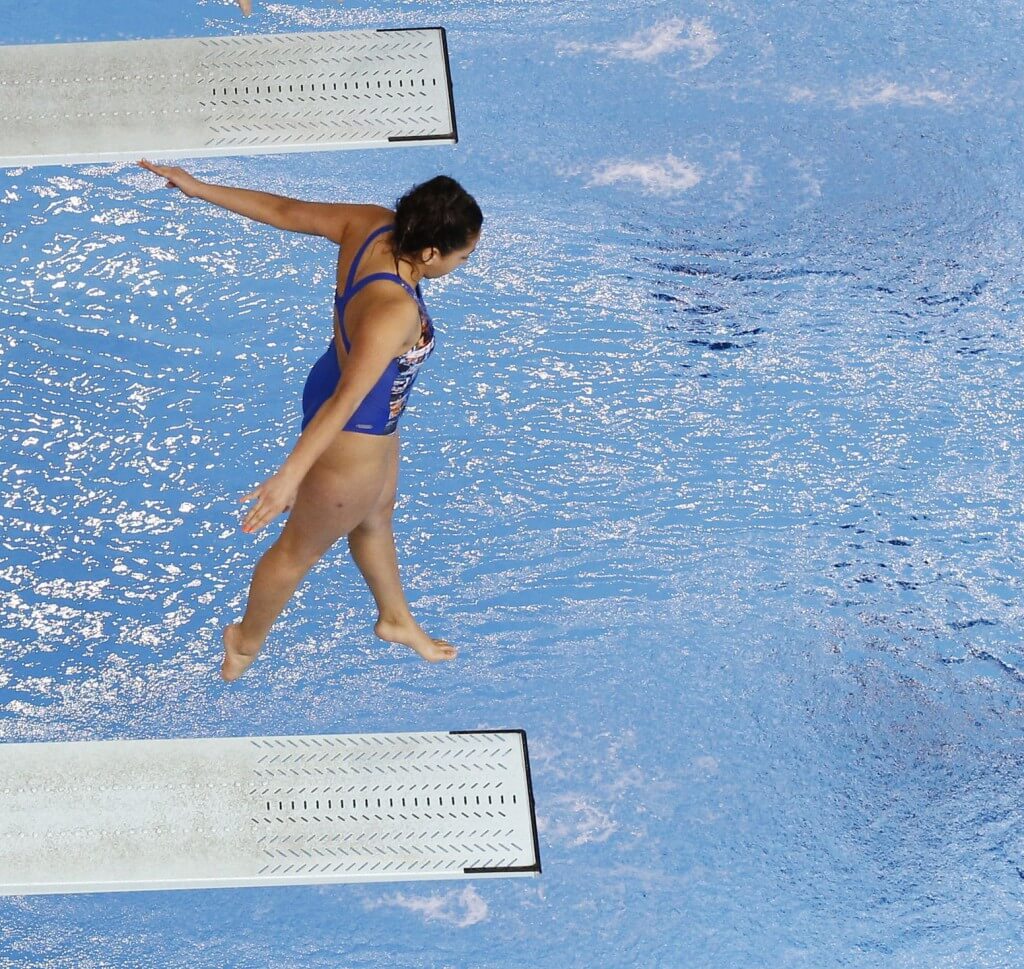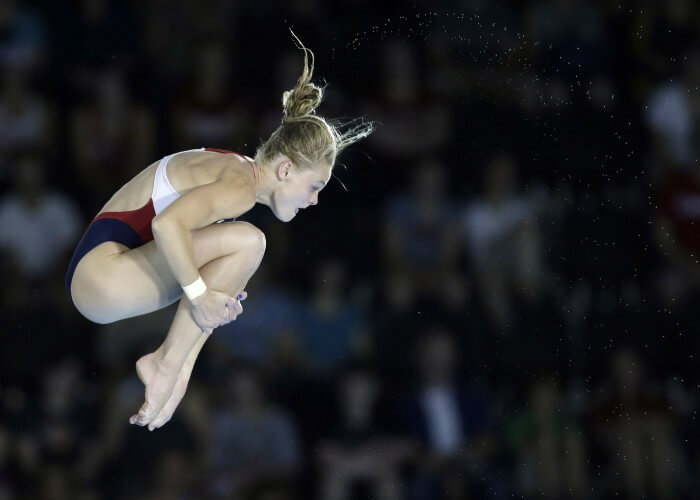Diving Lingo for Dummies

By Molly Lloyd, Swimming World College Intern
Do you wish you could understand that confusing, complicated diving lingo that divers are always spewing from their mouths? Do you – a supportive swimmer/teammate, family member, or friend of a diver – wish you could expand your knowledge, in hopes of better understanding and supporting your diver? Well do I have the article for you. This critically acclaimed* article can be your dictionary to that otherworldly diving slang that you hear so often.
Front – Front is the direction when a diver walks forward down the board and flip forward. Your typical, everyday front flip would fit into this category.
Back – Back is the direction where a diver stands backwards at the end of the board and flip backwards.
Inward – The inward direction is where a diver stands backwards at the end of the board, but instead of flipping backwards, they flip forward, back towards the board.
Reverse/Gainer – The reverse direction (otherwise known as the gainer) is considered the scariest direction and is where a diver walks forward down the board, but instead of flipping forward, they rotate backwards, toward the board.
Approach – The approach is the walk down the board that divers do before doing a front or reverse dive. Approaches range from usually three to five steps and come in a variety of different styles.
Hurdle – This is the point in the approach where a diver drives their knee up into the air in order to get more force with which to press the board down, in order to get good height on their dive.

Photo Courtesy: Rob Schumacher/USA Today Sports Images
Back approach/Back press – This is the series of oscillations that divers do before leaving the board on a back or inward dive. The number of oscillations ranges from two to about six, and they are usually followed by the diver going up on their toes and circling their arms backwards in order to have a good takeoff.
Crow hop – Crow hopping is when a diver leaves the board slightly while doing their back press, only to land back on the board and then leave the board for their takeoff. Crow hopping is bad.
Over/Long – This is when a diver kicks out too late or is too loose in their kick-out and they over rotate.
Under/Short – This is when a diver kicks out too early and they under rotate.
Kickout – This is when a diver fully extends out of the dive and straightens out in order to have a good entry into the water.
Up/Up Top/Upstairs – These are other terms for the three meter board.
Down/Downstairs – These are other terms for the one meter board.

Photo Courtesy: Peter H. Bick
Fulcrum – This is the circle on the side of the board that divers use to change the looseness or bouncy-ness of the board. The farther up the fulcrum, the more rigid the board is, and the farther back the fulcrum, the more bouncy it is.
Rip – When a diver “rips” a dive, this means that their entry into the water is vertical, with very little splash, and when their hands break the water tension, it makes a very loud, very satisfying smacking sound.
Smack – This is when a diver lands on the water incorrectly and the body “smacks” the water. Minor smacks can be harmless, but bad smacks can result in bruises, welts, and concussions.
Lead up/Build up – This is when a diver does a simpler dive to prepare themselves to do a bigger diver. For example, a diver will build up for a front double by doing a couple of front 1 1/2s beforehand.
Bail – Bailing is when a diver stops trying to do the diver while they’re already in the air because they don’t think they’ll be able to complete the dive. Bailing is never a good idea and usually ends with a smack.
Balk – Balking is when a diver stops their approach or press at the end of the board and don’t do the dive they were about to do. People balk for a number of reasons; they might be scared or their approach just doesn’t feel right. If a diver balks in a meet, judges will take off two points from their potential scores.

Photo Courtesy: Erich Schlegel/USA Today Sports Images
Spot – A spot is the place where a diver will look in order to know when to kick out of a dive. Their spot might be a spot on the wall, the ceiling, or the water.
Call/”Hup” – When a diver asks for a call, this means that they want their coach to yell “hup!” when they’re supposed to come out of a dive, because they don’t know where the out is. This is done when a diver is learning a new dive that they’ve never done before.
Chamois/Shammy – This is the super absorbent piece of cloth that all divers have on their person. Divers use their chamois to dry off their legs so they don’t slip out of their dives while in the air.
The Number System – Oh the dreaded number system. This, I believe, is what most people are confused about when watching diving. When watching diving, you might hear something like 103B and you might have wondering, what do those numbers and letters mean? To start, the first number denotes the direction of the dive. 1 = front, 2 = back, 3 = reverse, and 4 = inward. The 0 doesn’t actually mean anything, and the last number denotes the amount of half-flips the diver will be doing. So 1 would be a dive, 2 would be a full flip, and 3 would be a 1 1/2. Finally, the position of the dive is denoted by a letter. A = straight, B = pike, C = tuck, and D = free position. Using this system, you can figure out that 103B means a front 1 1/2 in the pike position.
It gets more confusing with twisters. The number 5 denotes the fact that the dive will be a twisting dive. The second number denotes the direction. The third number denotes the number of half-flips and the fourth number denotes the number of half twists. An example of this is a 5132D, which means a front 1 1/2 flips with one twist in the free position.
Well there you have it. Now you can consider yourself fluent in diving lingo; have fun at your next meet! Feel free to comment with any other terms/lingo/slang that I missed!
* – not actually critically acclaimed, I am but a college student.




Straight, pike,tuck, free mean what?
Straight is when your body doesn’t bend at all. Pike is a bend at the waist with straight legs (think stretching and trying to touch your toes). Tuck is when you are curled up into a ball. Free, which is only applied to twisters, means that it doesn’t matter what position you’re in as long as you get the dive done. The same dive in different positions have different degrees of difficulty.
Sara Hall
Can I make a note about the fulcrum. It’s actually how fast the board springs. The closer to end of the board the fulcrum is the faster the board will snap back, meaning the diver doesn’t have to wait as long for the board to snap.this is more useful for divers who are newer to the sport. Where the farther back the fulcrum the longer the board takes to snap, meaning the diver had to spend more time on the board before they start their dive. More elite and long time divers will have the fulcrum set in this way.
Thank you!